Corporate Accounting and Reporting: IAS 17 and Impairment
VerifiedAdded on 2021/05/30
|9
|1563
|17
Report
AI Summary
This report provides a detailed analysis of corporate accounting and reporting, focusing on finance leases and impairment losses. It begins with an overview of IAS 17, explaining accounting policies and disclosures for both lessees and lessors. The report highlights the disclosure requirements for finance leases, including the carrying amount of assets, reconciliation of lease payments, and contingent rents. Part A delves into the specifics of finance lease disclosures, while Part B presents a practical application with a case study on impairment loss allocation, including journal entries. The report covers the allocation of impairment loss across various assets, and the subsequent reallocation of the CGU (Cash Generating Unit). The journal entries record the impairment loss allocation to goodwill, land, equipment, and buildings. The analysis includes calculations and tables to illustrate the process. The report concludes by summarizing the key aspects of accounting for finance leases and impairment, providing a comprehensive understanding of the relevant accounting standards. The reference list provides the sources used in the report.
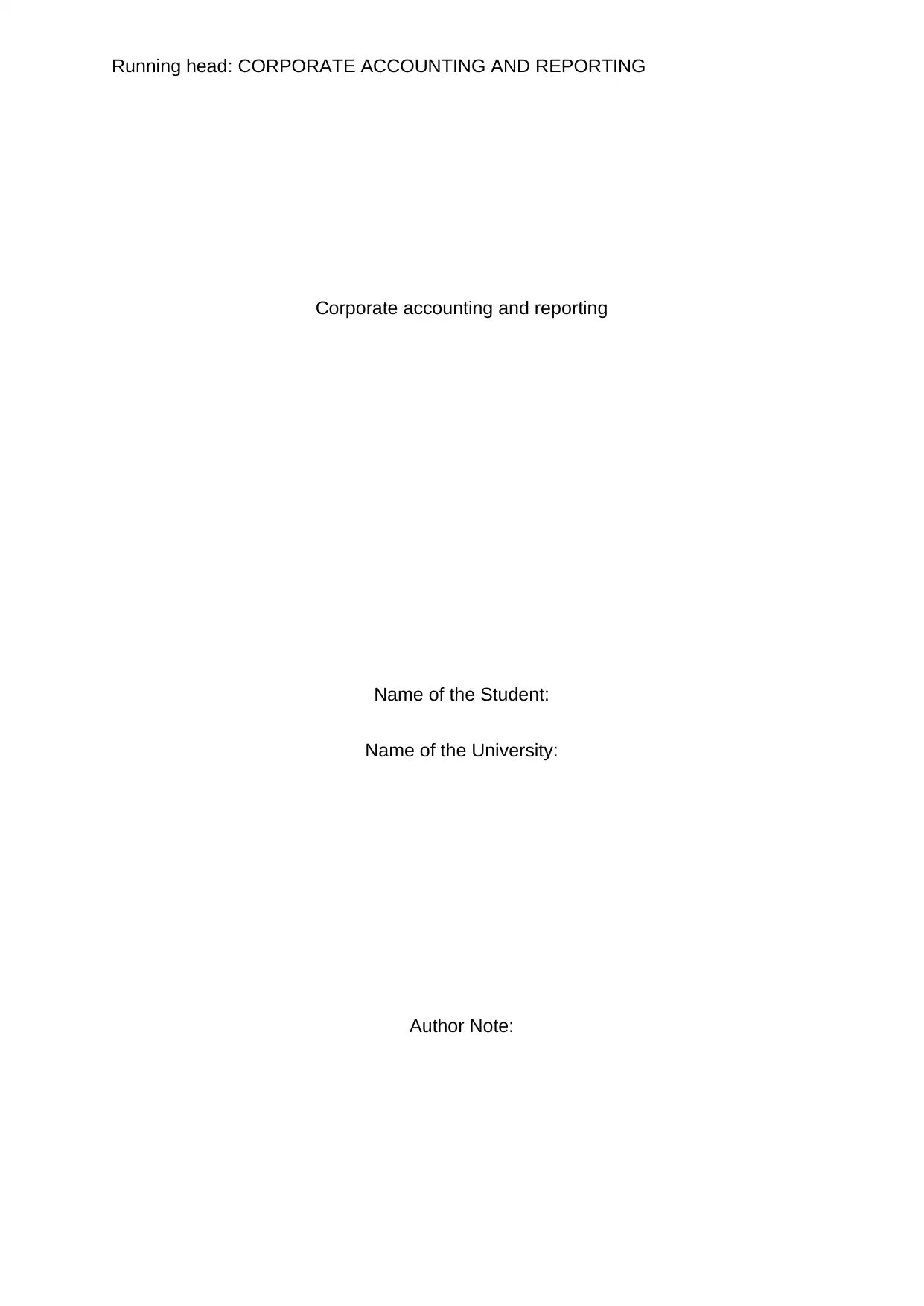
Running head: CORPORATE ACCOUNTING AND REPORTING
Corporate accounting and reporting
Name of the Student:
Name of the University:
Author Note:
Corporate accounting and reporting
Name of the Student:
Name of the University:
Author Note:
Paraphrase This Document
Need a fresh take? Get an instant paraphrase of this document with our AI Paraphraser

2CORPORATE ACCOUNTING AND REPORTING
Part A
Disclosure for Finance Leases
IAS 17 Leases explain about the accounting policies as well as disclosures
that are applicable to leases and it is for both lessees as well as lessors (Weidner
2017). In addition to that, Leases can be categorized into two types and these are
finance leases and operating leases. In this study, proper emphasis has been given
on understanding about finance leases that transfer substantially all the risks as well
as rewards of ownership and this can be done by giving rise to asset and liability
recognition by the lessee as well as receivable by the lessor in that case (Bertomeu,
Magee and Schneider 2018).
The main objective of IAS 17 is to propose on behalf of both lessees and
lessors on matters relating to suitable accounting policies as well as disclosures as it
is applicable in relation to both finance as well as operating leases (Spencer and
Webb 2015). Furthermore. IAS 17 fails to apply based on measurement for the given
leased assets such as biological assets that is held by the lessees under the finance
leases as it is mentioned in IAS 41 (Bertomeu, Magee and Schneider 2018).
Disclosure Lessees- Finance Leases (IAS 17.31)
In this disclosure, it is mentioned about the carrying amount of asset as well
as reconciliation that took place between minimum lease payments as well as their
present value at the same time (Osei 2017). It is all about the amount of minimum
lease payments as shown in the balance sheet date as well as present value that
include figures from the next year, years 2 and 3 combined and beyond 5 years. In
addition to that, the disclosure even mention about the contingent rent and this is
treated as expense. Furthermore, it is important to consider the total future minimum
Part A
Disclosure for Finance Leases
IAS 17 Leases explain about the accounting policies as well as disclosures
that are applicable to leases and it is for both lessees as well as lessors (Weidner
2017). In addition to that, Leases can be categorized into two types and these are
finance leases and operating leases. In this study, proper emphasis has been given
on understanding about finance leases that transfer substantially all the risks as well
as rewards of ownership and this can be done by giving rise to asset and liability
recognition by the lessee as well as receivable by the lessor in that case (Bertomeu,
Magee and Schneider 2018).
The main objective of IAS 17 is to propose on behalf of both lessees and
lessors on matters relating to suitable accounting policies as well as disclosures as it
is applicable in relation to both finance as well as operating leases (Spencer and
Webb 2015). Furthermore. IAS 17 fails to apply based on measurement for the given
leased assets such as biological assets that is held by the lessees under the finance
leases as it is mentioned in IAS 41 (Bertomeu, Magee and Schneider 2018).
Disclosure Lessees- Finance Leases (IAS 17.31)
In this disclosure, it is mentioned about the carrying amount of asset as well
as reconciliation that took place between minimum lease payments as well as their
present value at the same time (Osei 2017). It is all about the amount of minimum
lease payments as shown in the balance sheet date as well as present value that
include figures from the next year, years 2 and 3 combined and beyond 5 years. In
addition to that, the disclosure even mention about the contingent rent and this is
treated as expense. Furthermore, it is important to consider the total future minimum
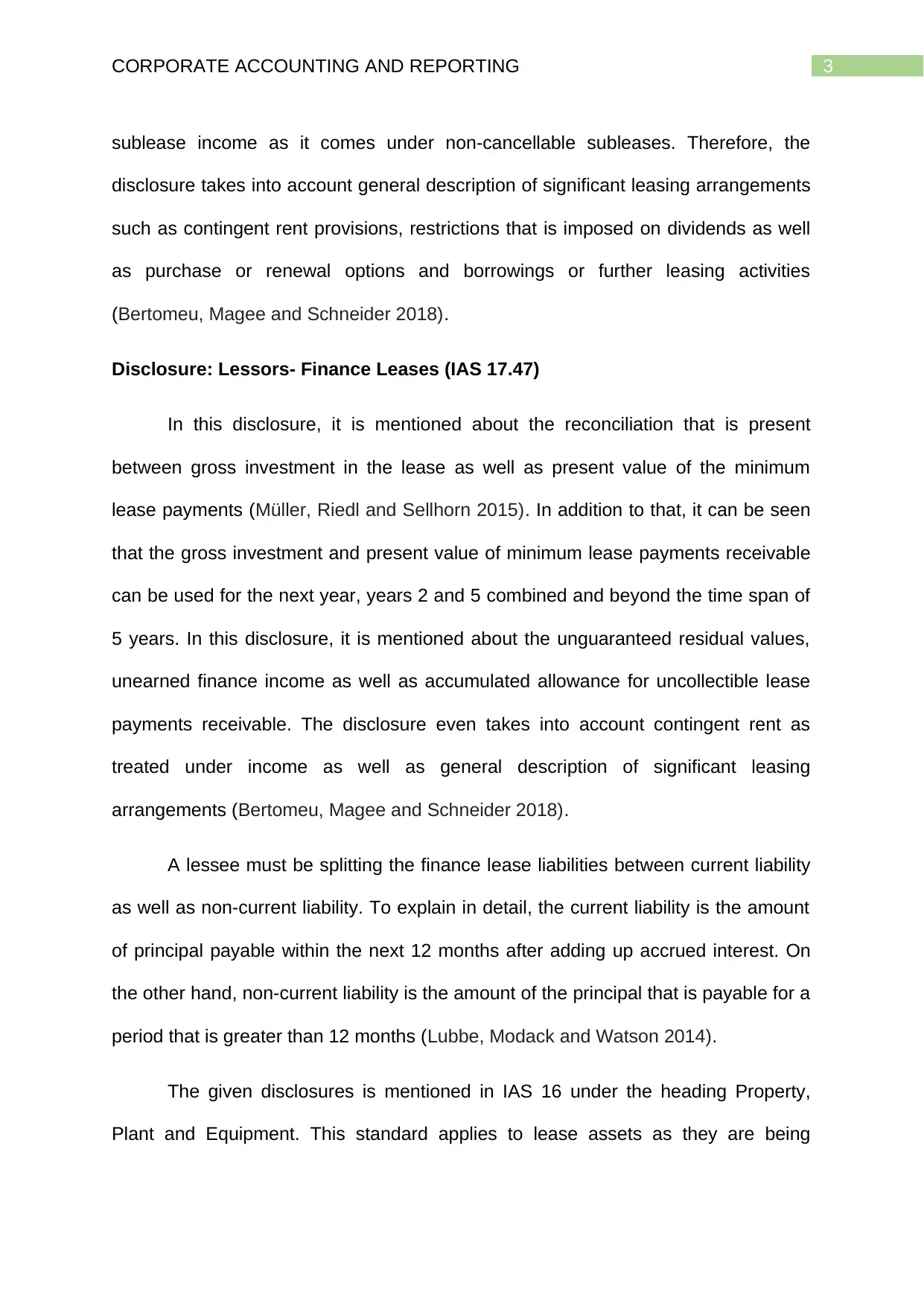
3CORPORATE ACCOUNTING AND REPORTING
sublease income as it comes under non-cancellable subleases. Therefore, the
disclosure takes into account general description of significant leasing arrangements
such as contingent rent provisions, restrictions that is imposed on dividends as well
as purchase or renewal options and borrowings or further leasing activities
(Bertomeu, Magee and Schneider 2018).
Disclosure: Lessors- Finance Leases (IAS 17.47)
In this disclosure, it is mentioned about the reconciliation that is present
between gross investment in the lease as well as present value of the minimum
lease payments (Müller, Riedl and Sellhorn 2015). In addition to that, it can be seen
that the gross investment and present value of minimum lease payments receivable
can be used for the next year, years 2 and 5 combined and beyond the time span of
5 years. In this disclosure, it is mentioned about the unguaranteed residual values,
unearned finance income as well as accumulated allowance for uncollectible lease
payments receivable. The disclosure even takes into account contingent rent as
treated under income as well as general description of significant leasing
arrangements (Bertomeu, Magee and Schneider 2018).
A lessee must be splitting the finance lease liabilities between current liability
as well as non-current liability. To explain in detail, the current liability is the amount
of principal payable within the next 12 months after adding up accrued interest. On
the other hand, non-current liability is the amount of the principal that is payable for a
period that is greater than 12 months (Lubbe, Modack and Watson 2014).
The given disclosures is mentioned in IAS 16 under the heading Property,
Plant and Equipment. This standard applies to lease assets as they are being
sublease income as it comes under non-cancellable subleases. Therefore, the
disclosure takes into account general description of significant leasing arrangements
such as contingent rent provisions, restrictions that is imposed on dividends as well
as purchase or renewal options and borrowings or further leasing activities
(Bertomeu, Magee and Schneider 2018).
Disclosure: Lessors- Finance Leases (IAS 17.47)
In this disclosure, it is mentioned about the reconciliation that is present
between gross investment in the lease as well as present value of the minimum
lease payments (Müller, Riedl and Sellhorn 2015). In addition to that, it can be seen
that the gross investment and present value of minimum lease payments receivable
can be used for the next year, years 2 and 5 combined and beyond the time span of
5 years. In this disclosure, it is mentioned about the unguaranteed residual values,
unearned finance income as well as accumulated allowance for uncollectible lease
payments receivable. The disclosure even takes into account contingent rent as
treated under income as well as general description of significant leasing
arrangements (Bertomeu, Magee and Schneider 2018).
A lessee must be splitting the finance lease liabilities between current liability
as well as non-current liability. To explain in detail, the current liability is the amount
of principal payable within the next 12 months after adding up accrued interest. On
the other hand, non-current liability is the amount of the principal that is payable for a
period that is greater than 12 months (Lubbe, Modack and Watson 2014).
The given disclosures is mentioned in IAS 16 under the heading Property,
Plant and Equipment. This standard applies to lease assets as they are being
⊘ This is a preview!⊘
Do you want full access?
Subscribe today to unlock all pages.

Trusted by 1+ million students worldwide

4CORPORATE ACCOUNTING AND REPORTING
treated as tangible non-current assets and shown in the financial statements of the
lessee (Bertomeu, Magee and Schneider 2018).
It is important to understand the fact that IAS 17 need the several disclosures
as shown in the financial statements of the lessee (Lim, Mann and Mihov 2014). In
this, it can be seen that each of the given class of asset had to be held under finance
leases at the end of the reporting period by considering the net carrying amount at
the same time (Bertomeu, Magee and Schneider 2018). In addition to that, a
reconciliation or analysis of the total future minimum leases payments are treated at
the end of the reporting period by viewing at the present value of future minimum
lease payments as it takes into account dividend into amount as it is falling due
values under discounted to payment day values in the most effective way ( Gordon et
al. 2015).
On analysis, it can be seen that general description of the material leasing
arrangements of the lessee takes into account details of contingent rent payable as
well as purchase of escalation clauses after adding lease restrictions in place and
these are for dividends, dents and even considering further leasing restrictions
(Bertomeu, Magee and Schneider 2018). In addition to that, contingent rents can be
treated as expenses for a given period of time. As far as contingent rent is
considered, it can be seen that the amount above the minimum leases payments
cannot be kept fixed by nature. Some of the factors are taken into consideration for
instance, linking with important factors like sales in case of retail unit, interest rates
as well as price index at the same time (Lim, Mann and Mihov 2014).
At the end of the section, it can be concluded that disclosure requirements are
done for both (lessee and lessors) and even it is applied equally at the time of
treated as tangible non-current assets and shown in the financial statements of the
lessee (Bertomeu, Magee and Schneider 2018).
It is important to understand the fact that IAS 17 need the several disclosures
as shown in the financial statements of the lessee (Lim, Mann and Mihov 2014). In
this, it can be seen that each of the given class of asset had to be held under finance
leases at the end of the reporting period by considering the net carrying amount at
the same time (Bertomeu, Magee and Schneider 2018). In addition to that, a
reconciliation or analysis of the total future minimum leases payments are treated at
the end of the reporting period by viewing at the present value of future minimum
lease payments as it takes into account dividend into amount as it is falling due
values under discounted to payment day values in the most effective way ( Gordon et
al. 2015).
On analysis, it can be seen that general description of the material leasing
arrangements of the lessee takes into account details of contingent rent payable as
well as purchase of escalation clauses after adding lease restrictions in place and
these are for dividends, dents and even considering further leasing restrictions
(Bertomeu, Magee and Schneider 2018). In addition to that, contingent rents can be
treated as expenses for a given period of time. As far as contingent rent is
considered, it can be seen that the amount above the minimum leases payments
cannot be kept fixed by nature. Some of the factors are taken into consideration for
instance, linking with important factors like sales in case of retail unit, interest rates
as well as price index at the same time (Lim, Mann and Mihov 2014).
At the end of the section, it can be concluded that disclosure requirements are
done for both (lessee and lessors) and even it is applied equally at the time of
Paraphrase This Document
Need a fresh take? Get an instant paraphrase of this document with our AI Paraphraser
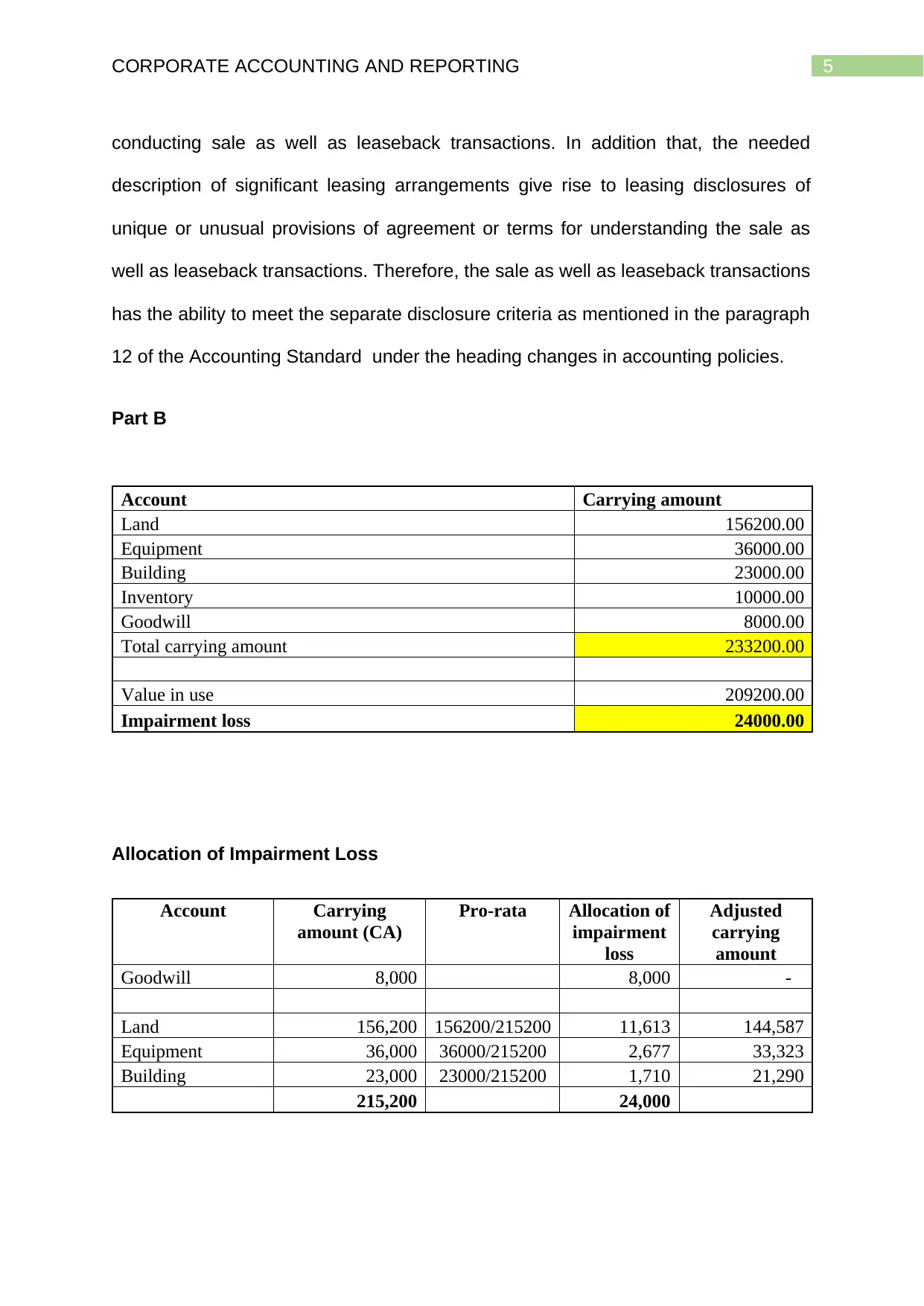
5CORPORATE ACCOUNTING AND REPORTING
conducting sale as well as leaseback transactions. In addition that, the needed
description of significant leasing arrangements give rise to leasing disclosures of
unique or unusual provisions of agreement or terms for understanding the sale as
well as leaseback transactions. Therefore, the sale as well as leaseback transactions
has the ability to meet the separate disclosure criteria as mentioned in the paragraph
12 of the Accounting Standard under the heading changes in accounting policies.
Part B
Account Carrying amount
Land 156200.00
Equipment 36000.00
Building 23000.00
Inventory 10000.00
Goodwill 8000.00
Total carrying amount 233200.00
Value in use 209200.00
Impairment loss 24000.00
Allocation of Impairment Loss
Account Carrying
amount (CA)
Pro-rata Allocation of
impairment
loss
Adjusted
carrying
amount
Goodwill 8,000 8,000 -
Land 156,200 156200/215200 11,613 144,587
Equipment 36,000 36000/215200 2,677 33,323
Building 23,000 23000/215200 1,710 21,290
215,200 24,000
conducting sale as well as leaseback transactions. In addition that, the needed
description of significant leasing arrangements give rise to leasing disclosures of
unique or unusual provisions of agreement or terms for understanding the sale as
well as leaseback transactions. Therefore, the sale as well as leaseback transactions
has the ability to meet the separate disclosure criteria as mentioned in the paragraph
12 of the Accounting Standard under the heading changes in accounting policies.
Part B
Account Carrying amount
Land 156200.00
Equipment 36000.00
Building 23000.00
Inventory 10000.00
Goodwill 8000.00
Total carrying amount 233200.00
Value in use 209200.00
Impairment loss 24000.00
Allocation of Impairment Loss
Account Carrying
amount (CA)
Pro-rata Allocation of
impairment
loss
Adjusted
carrying
amount
Goodwill 8,000 8,000 -
Land 156,200 156200/215200 11,613 144,587
Equipment 36,000 36000/215200 2,677 33,323
Building 23,000 23000/215200 1,710 21,290
215,200 24,000
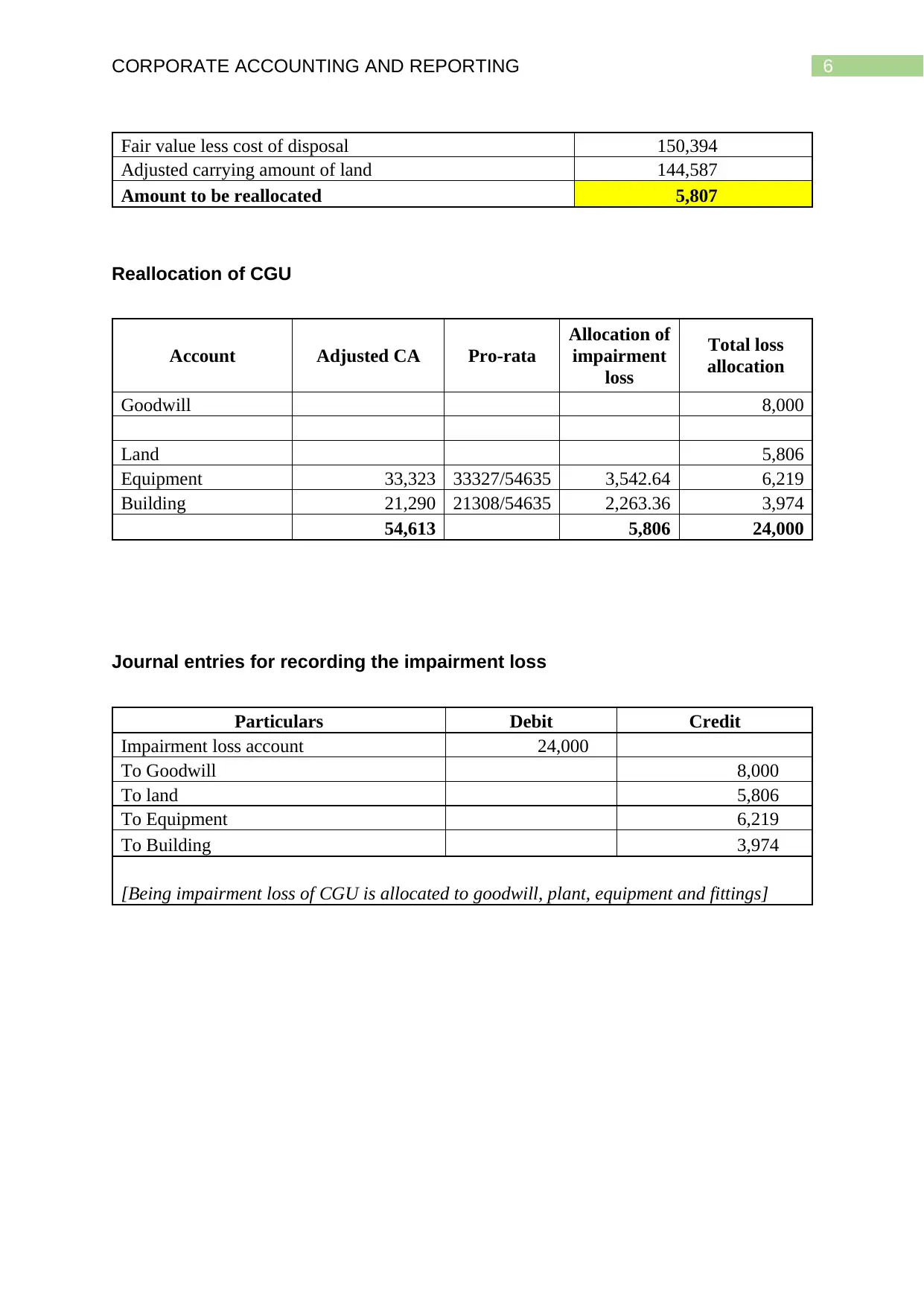
6CORPORATE ACCOUNTING AND REPORTING
Fair value less cost of disposal 150,394
Adjusted carrying amount of land 144,587
Amount to be reallocated 5,807
Reallocation of CGU
Account Adjusted CA Pro-rata
Allocation of
impairment
loss
Total loss
allocation
Goodwill 8,000
Land 5,806
Equipment 33,323 33327/54635 3,542.64 6,219
Building 21,290 21308/54635 2,263.36 3,974
54,613 5,806 24,000
Journal entries for recording the impairment loss
Particulars Debit Credit
Impairment loss account 24,000
To Goodwill 8,000
To land 5,806
To Equipment 6,219
To Building 3,974
[Being impairment loss of CGU is allocated to goodwill, plant, equipment and fittings]
Fair value less cost of disposal 150,394
Adjusted carrying amount of land 144,587
Amount to be reallocated 5,807
Reallocation of CGU
Account Adjusted CA Pro-rata
Allocation of
impairment
loss
Total loss
allocation
Goodwill 8,000
Land 5,806
Equipment 33,323 33327/54635 3,542.64 6,219
Building 21,290 21308/54635 2,263.36 3,974
54,613 5,806 24,000
Journal entries for recording the impairment loss
Particulars Debit Credit
Impairment loss account 24,000
To Goodwill 8,000
To land 5,806
To Equipment 6,219
To Building 3,974
[Being impairment loss of CGU is allocated to goodwill, plant, equipment and fittings]
⊘ This is a preview!⊘
Do you want full access?
Subscribe today to unlock all pages.

Trusted by 1+ million students worldwide

7CORPORATE ACCOUNTING AND REPORTING
Paraphrase This Document
Need a fresh take? Get an instant paraphrase of this document with our AI Paraphraser
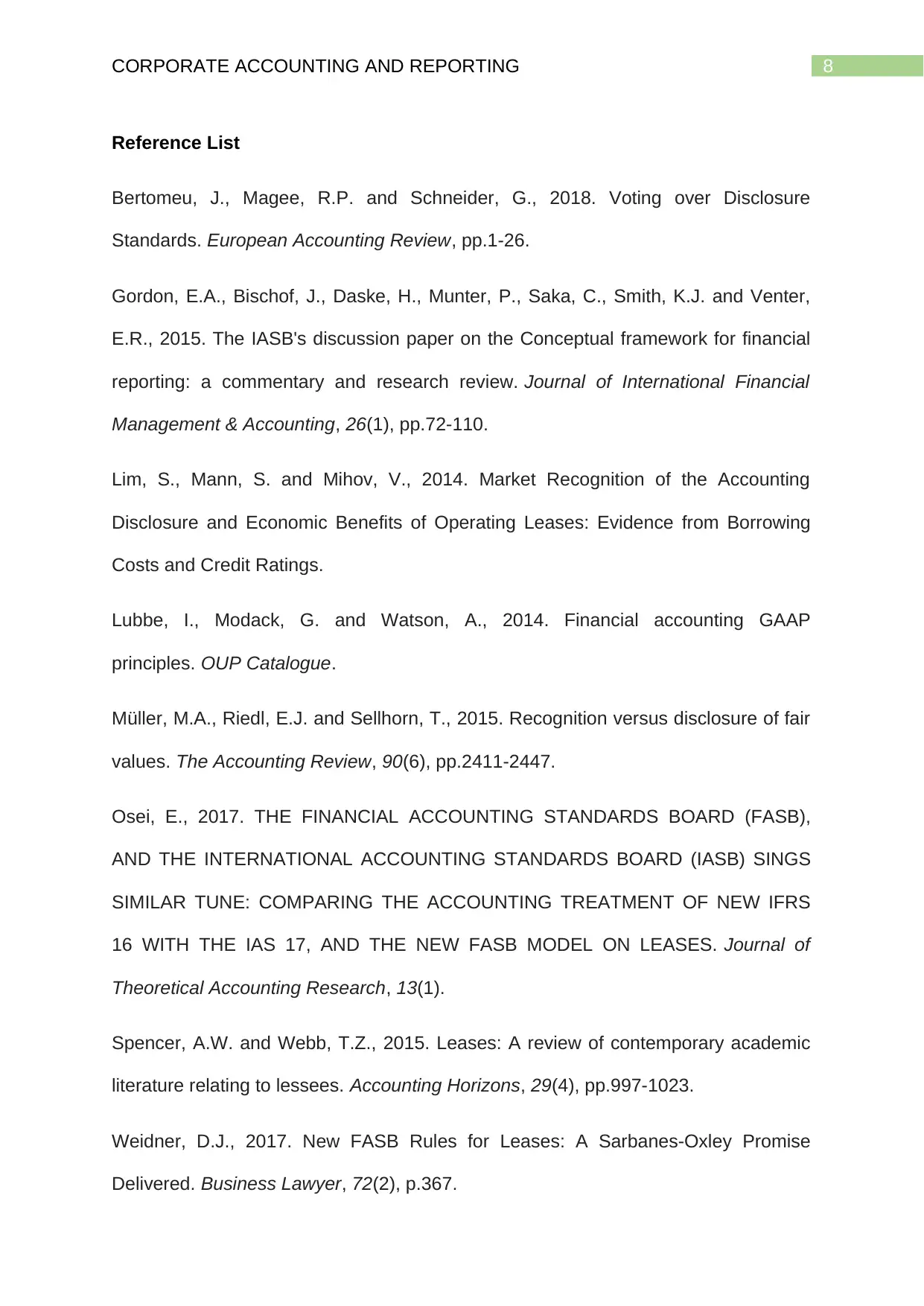
8CORPORATE ACCOUNTING AND REPORTING
Reference List
Bertomeu, J., Magee, R.P. and Schneider, G., 2018. Voting over Disclosure
Standards. European Accounting Review, pp.1-26.
Gordon, E.A., Bischof, J., Daske, H., Munter, P., Saka, C., Smith, K.J. and Venter,
E.R., 2015. The IASB's discussion paper on the Conceptual framework for financial
reporting: a commentary and research review. Journal of International Financial
Management & Accounting, 26(1), pp.72-110.
Lim, S., Mann, S. and Mihov, V., 2014. Market Recognition of the Accounting
Disclosure and Economic Benefits of Operating Leases: Evidence from Borrowing
Costs and Credit Ratings.
Lubbe, I., Modack, G. and Watson, A., 2014. Financial accounting GAAP
principles. OUP Catalogue.
Müller, M.A., Riedl, E.J. and Sellhorn, T., 2015. Recognition versus disclosure of fair
values. The Accounting Review, 90(6), pp.2411-2447.
Osei, E., 2017. THE FINANCIAL ACCOUNTING STANDARDS BOARD (FASB),
AND THE INTERNATIONAL ACCOUNTING STANDARDS BOARD (IASB) SINGS
SIMILAR TUNE: COMPARING THE ACCOUNTING TREATMENT OF NEW IFRS
16 WITH THE IAS 17, AND THE NEW FASB MODEL ON LEASES. Journal of
Theoretical Accounting Research, 13(1).
Spencer, A.W. and Webb, T.Z., 2015. Leases: A review of contemporary academic
literature relating to lessees. Accounting Horizons, 29(4), pp.997-1023.
Weidner, D.J., 2017. New FASB Rules for Leases: A Sarbanes-Oxley Promise
Delivered. Business Lawyer, 72(2), p.367.
Reference List
Bertomeu, J., Magee, R.P. and Schneider, G., 2018. Voting over Disclosure
Standards. European Accounting Review, pp.1-26.
Gordon, E.A., Bischof, J., Daske, H., Munter, P., Saka, C., Smith, K.J. and Venter,
E.R., 2015. The IASB's discussion paper on the Conceptual framework for financial
reporting: a commentary and research review. Journal of International Financial
Management & Accounting, 26(1), pp.72-110.
Lim, S., Mann, S. and Mihov, V., 2014. Market Recognition of the Accounting
Disclosure and Economic Benefits of Operating Leases: Evidence from Borrowing
Costs and Credit Ratings.
Lubbe, I., Modack, G. and Watson, A., 2014. Financial accounting GAAP
principles. OUP Catalogue.
Müller, M.A., Riedl, E.J. and Sellhorn, T., 2015. Recognition versus disclosure of fair
values. The Accounting Review, 90(6), pp.2411-2447.
Osei, E., 2017. THE FINANCIAL ACCOUNTING STANDARDS BOARD (FASB),
AND THE INTERNATIONAL ACCOUNTING STANDARDS BOARD (IASB) SINGS
SIMILAR TUNE: COMPARING THE ACCOUNTING TREATMENT OF NEW IFRS
16 WITH THE IAS 17, AND THE NEW FASB MODEL ON LEASES. Journal of
Theoretical Accounting Research, 13(1).
Spencer, A.W. and Webb, T.Z., 2015. Leases: A review of contemporary academic
literature relating to lessees. Accounting Horizons, 29(4), pp.997-1023.
Weidner, D.J., 2017. New FASB Rules for Leases: A Sarbanes-Oxley Promise
Delivered. Business Lawyer, 72(2), p.367.

9CORPORATE ACCOUNTING AND REPORTING
⊘ This is a preview!⊘
Do you want full access?
Subscribe today to unlock all pages.

Trusted by 1+ million students worldwide
1 out of 9
Related Documents
Your All-in-One AI-Powered Toolkit for Academic Success.
+13062052269
info@desklib.com
Available 24*7 on WhatsApp / Email
![[object Object]](/_next/static/media/star-bottom.7253800d.svg)
Unlock your academic potential
Copyright © 2020–2025 A2Z Services. All Rights Reserved. Developed and managed by ZUCOL.




